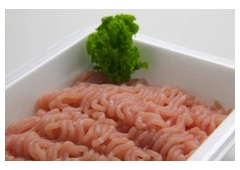
Meat irradiation can reduce pathogen levels to zero
Food in Canada
Food Safety Meat &Poultry campylobacter food science salmonellaAfter noting risky food preparation behaviours in consumer kitchens, a food scientist and consumer behaviour expert from the University of California calls for meat irradiation

Davis, Calif. – A food science and consumer behaviour expert from the University of California, Davis, says irradiating meat can reduce Salmonella and Campylobacter levels to almost zero.
Christine Bruhn, Cooperative Extension specialist in the Department of Food Science and Technology, says in a recent study that irradiating meat would make it safer for consumers who aren’t handling raw meat properly.
But irradiation is just not gaining traction.
Bruhn says she and her team analyzed video footage of 120 consumers preparing a self-selected chicken dish and salad in their home kitchens.
The study found that 65 per cent did not wash their hands before starting the meal and 38 per cent didn’t wash their hands after touching raw chicken. The team also noted other food preparation practices that increase the likelihood of causing foodborne illness.
“People don’t realize what they are doing with their hands, especially after touching raw poultry,” says Bruhn.
“To take an example, if you had honey poured on the chicken, you touch the honey and touch the cupboard and the door handle, it is spread all over everything and cross contaminates the kitchen.”
The university says the study has prompted a number of organizations to launch educational campaigns to increase consumer knowledge about safe food preparation practices at home.
Bruhn recommends wider use of irradiation of meat. Irradiation can be done by gamma rays, X-rays or electron beam. Past concerns about furan presence, says FoodQualityNews.com, is a potential concern because based on high-dose animal test, it is considered possibly carcinogenic to humans.
She adds that meat vendors are concerned that consumers will reject irradiated food, a sentiment she considers a “cop out.” According to Bruhn, “Supermarkets are the gatekeepers. It is not the consumer blocking it.”
Other observations from the study
Cross contamination:
• Most participants, 65 per cent, did not wash their hands before starting meal preparation and 38 per cent did not wash their hands after touching raw chicken.
• Only 10 per cent of participants washed their hands for the recommended duration of 20 seconds and about one-third of the washing occasions used water only, without soap.
• Nearly 50 per cent of participants were observed washing their chicken in the sink prior to preparation, a practice that is not recommended as it leads to spreading bacteria over multiple surfaces in the kitchen.
Insufficient cooking:
• 40 per cent of participants undercooked their chicken, regardless of preparation method and only 29 per cent knew the correct USDA recommended temperature of 165 degrees Fahrenheit.
• Researchers observed that cooking thermometers were not widely used, with only 48 per cent of participants owning one, and 69 per cent of those reporting that they seldom use it to check if chicken is completely cooked. Most participants determined “fully cooked” based on appearance, an unreliable method according to the USDA. No participants reported calibrating their thermometers to ensure accuracy.
Print this page